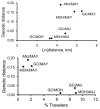Genetic structure of Plasmodium falciparum and elimination of malaria, Comoros archipelago
- PMID: 21029525
- PMCID: PMC3294527
- DOI: 10.3201/eid1611.100694
Genetic structure of Plasmodium falciparum and elimination of malaria, Comoros archipelago
Abstract
The efficacy of malaria control and elimination on islands may depend on the intensity of new parasite inflow. On the Comoros archipelago, where falciparum malaria remains a major public health problem because of spread of drug resistance and insufficient malaria control, recent interventions for malaria elimination were planned on Moheli, 1 of 4 islands in the Comoros archipelago. To assess the relevance of such a local strategy, we performed a population genetics analysis by using multilocus microsatellite and resistance genotyping of Plasmodium falciparum sampled from each island of the archipelago. We found a contrasted population genetic structure explained by geographic isolation, human migration, malaria transmission, and drug selective pressure. Our findings suggest that malaria elimination interventions should be implemented simultaneously on the entire archipelago rather than restricted to 1 island and demonstrate the necessity for specific chemoresistance surveillance on each of the 4 Comorian islands.
Figures



Similar articles
-
[Malaria in the Comoros Archipelago in 2015: status after 15 years of fight].Bull Soc Pathol Exot. 2016 May;109(2):107-13. doi: 10.1007/s13149-016-0489-y. Epub 2016 Apr 21. Bull Soc Pathol Exot. 2016. PMID: 27160218 French.
-
Antimalarial drug susceptibility and point mutations associated with drug resistance in 248 Plasmodium falciparum isolates imported from Comoros to Marseille, France in 2004 2006.Am J Trop Med Hyg. 2007 Sep;77(3):431-7. Am J Trop Med Hyg. 2007. PMID: 17827355
-
Polymorphisms of the artemisinin resistant marker (K13) in Plasmodium falciparum parasite populations of Grande Comore Island 10 years after artemisinin combination therapy.Parasit Vectors. 2015 Dec 15;8:634. doi: 10.1186/s13071-015-1253-z. Parasit Vectors. 2015. PMID: 26667053 Free PMC article.
-
Spread and evolution of Plasmodium falciparum drug resistance.Parasitol Int. 2009 Sep;58(3):201-9. doi: 10.1016/j.parint.2009.04.004. Epub 2009 Apr 23. Parasitol Int. 2009. PMID: 19393762 Review.
-
Genetic surveillance for monitoring the impact of drug use on Plasmodium falciparum populations.Int J Parasitol Drugs Drug Resist. 2021 Dec;17:12-22. doi: 10.1016/j.ijpddr.2021.07.004. Epub 2021 Jul 26. Int J Parasitol Drugs Drug Resist. 2021. PMID: 34333350 Free PMC article. Review.
Cited by
-
K13-Propeller Polymorphisms in Plasmodium falciparum Isolates from Patients in Mayotte in 2013 and 2014.Antimicrob Agents Chemother. 2015 Dec;59(12):7878-81. doi: 10.1128/AAC.01251-15. Epub 2015 Sep 28. Antimicrob Agents Chemother. 2015. PMID: 26416865 Free PMC article.
-
The geography of malaria genetics in the Democratic Republic of Congo: A complex and fragmented landscape.Soc Sci Med. 2015 May;133:233-41. doi: 10.1016/j.socscimed.2014.10.037. Epub 2014 Oct 19. Soc Sci Med. 2015. PMID: 25459204 Free PMC article.
-
Major decrease in malaria transmission on Mayotte Island.Malar J. 2015 Aug 19;14:323. doi: 10.1186/s12936-015-0837-6. Malar J. 2015. PMID: 26285699 Free PMC article.
-
MALDI-TOF MS identification of Anopheles gambiae Giles blood meal crushed on Whatman filter papers.PLoS One. 2017 Aug 17;12(8):e0183238. doi: 10.1371/journal.pone.0183238. eCollection 2017. PLoS One. 2017. PMID: 28817629 Free PMC article.
-
Contrasting Transmission Dynamics of Co-endemic Plasmodium vivax and P. falciparum: Implications for Malaria Control and Elimination.PLoS Negl Trop Dis. 2015 May 7;9(5):e0003739. doi: 10.1371/journal.pntd.0003739. eCollection 2015 May. PLoS Negl Trop Dis. 2015. PMID: 25951184 Free PMC article.
References
-
- Roll Back Malaria Partnership. The global malaria action plan, for a malaria-free world. Geneva: World Health Organization; 2008. [cited 2010 Sep 5]. http://www.rollbackmalaria.org/gmap/index.html
-
- World Health Organization. World malaria report 2009. Geneva: The Organization; 2009. [cited 2010 Sep 5]. http://www.who.int/malaria/publications/atoz/9789241563901/en/index.html
-
- Bogreau H, Renaud F, Bouchiba H, Durand P, Assi SB, Henry MC, et al. Genetic diversity and structure of African Plasmodium falciparum populations in urban and rural areas. Am J Trop Med Hyg. 2006;74:953–9. - PubMed
-
- Anderson TJ, Haubold B, Williams JT, Estrada-Franco JG, Richardson L, Mollinedo R, et al. Microsatellite markers reveal a spectrum of population structures in the malaria parasite Plasmodium falciparum. Mol Biol Evol. 2000;17:1467–82. - PubMed
Publication types
MeSH terms
Substances
LinkOut - more resources
Full Text Sources
